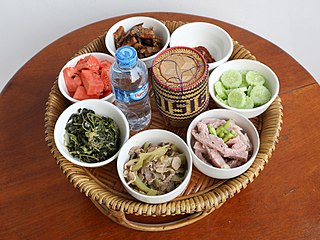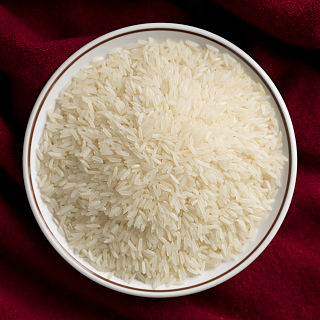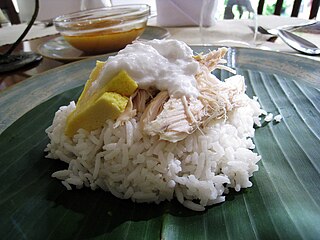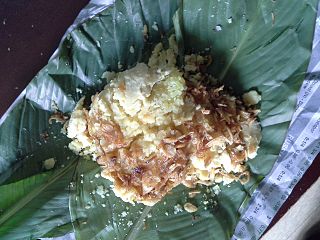
Thai cuisine is the national cuisine of Thailand.

Lao cuisine or Laotian cuisine is the national cuisine of Laos.

Glutinous rice is a type of rice grown mainly in Southeast and East Asia, and the northeastern regions of South Asia, which has opaque grains, very low amylose content, and is especially sticky when cooked. It is widely consumed across Asia.

Khmer cuisine combines the culinary traditions of many different ethnic groups in Cambodia, an important subset of which is Khmer cuisine, the nearly-two-thousand-year-old culinary tradition of the majority Khmer people. Over centuries, Cambodian cuisine has incorporated elements of Indian, Chinese, Portuguese and French cuisine, and due to some of these shared influences and mutual interaction, it has many similarities with the cuisines of Central Thailand, and Southern Vietnam and to a lesser extent also Central Vietnam, Northeastern Thailand and Laos.

Kai yang or gai yang, also known as kai ping or gai ping, or pīng kai, is a Lao dish originating in Laos, but it is now commonly eaten throughout the whole of Thailand. The dish is a standard staple of street markets and readily available at all times. Some regions of Laos become popular because of their flavorful and tender Ping Kai prepared using unique ingredients for marinating and techniques for grilling the meats. Being a typical Laotian dish, it is often paired with green papaya salad and sticky rice or eaten with sticky rice in bamboo. It is also eaten with raw vegetables, and often dipped in spicy sauces such as Laotian jaew bong.

Flattened rice is a preparation of rice made from raw, toasted, or parboiled rice grains pounded into flat flakes. It is traditional to many rice-cultivating cultures in Southeast Asia and South Asia. It is also known as rice flakes, beaten rice, pounded rice, pressed rice or chipped rice.

Noodle soup refers to a variety of soups with noodles and other ingredients served in a light broth. Noodle soup is a common dish across East Asia, Southeast Asia and the Himalayan states of South Asia. Various types of noodles are used, such as rice noodles, wheat noodles and egg noodles.

Jasmine rice is a long-grain variety of fragrant rice. Its fragrance, reminiscent of pandan and popcorn, results from the rice plant's natural production of aroma compounds, of which 2-acetyl-1-pyrroline is the most salient. A rapid loss of aromatic intensity leads many Southeast Asians and connoisseurs to prefer each year's freshly harvested "new crop" of jasmine rice. Jasmine rice is a variety of Oryza sativa.

A rice cake may be any kind of food item made from rice that has been shaped, condensed, or otherwise combined into a single object. A wide variety of rice cakes exist in many different cultures in which rice is eaten. Common variations include cakes made with rice flour, those made from ground rice, and those made from whole grains of rice compressed together or combined with some other binding substance.

Lemang is a Minangkabau traditional food made from glutinous rice, coconut milk, and salt, cooked in a hollowed bamboo tube coated with banana leaves in order to prevent the rice from sticking to the bamboo. Originating in Indonesia, it is also found in Singapore, Malaysia, and Brunei, as similar dishes made from sticky rice in bamboo are common throughout Mainland Southeast Asia.

Coconut rice is a dish prepared by cooking white rice in coconut milk or coconut flakes. As both the coconut and the rice-plant are commonly found in the tropics all around the world, coconut rice, too, is found in many cultures throughout the world, spanning across the equator from Southeast Asia, the Indian subcontinent, South America, Central America, West Africa, East Africa, the Caribbean and Oceania.

Cooked rice refers to rice that has been cooked either by steaming or boiling. The terms steamed rice or boiled rice are also commonly used. Any variant of Asian rice, African rice or wild rice, glutinous or non-glutinous, long-, medium-, or short-grain, of any colour, can be used. Rice for cooking can be whole grain or milled.

Xôi is a savory (mặn) or sweet (ngọt) Vietnamese dish made from glutinous rice and other ingredients. Xôi is a common on-the-go breakfast item, and a popular snack nationwide. Although it is often served as a breakfast or dessert, people also eat it at lunch or dinner as a main dish in many areas in Vietnam.

Khao tom and khao tom mat are a popular Laotian and Thai dessert made of sticky rice, ripe banana, coconut milk, all wrapped and steamed-cooked in banana leaves. A similar dessert is enjoyed throughout Southeast Asian countries where it is known as Num ansom in Khmer, lepet in Indonesian, suman in Filipino, bánh tét and bánh chưng in Vietnamese.

Steamed curry is a Southeast Asian type of curry steam-cooked in banana leaves and served with cooked rice. In Laos, it is also roasted on embers. The base of the curry is made with a curry paste with or without the addition of coconut cream or coconut milk and eggs. A wide range of leaves and staple ingredients are also added to the dish, such as:
A khantoke or khantok is a pedestal tray used as a small dining table by the Lanna people, Laotians, and by people from Isan. A khantoke tray is a short, round table, made of several different materials such as: wood, bamboo or rattan. It has a diameter of about 35 centimetres (14 in) but can vary in size and use case. It is comparable to the daunglan traditionally used in Burmese cuisine.

Bua loi or bua loy is a Thai dessert. It consists of rice flour rolled into small balls, and cooked in coconut milk and sugar. Some Bua loi also adds sweet egg into the recipe. It was inspired by Tangyuan, a Chinese dessert that is traditionally eaten around the Lantern festival. Bua Loi is also traditionally eaten during the Dongzhi Festival in Thailand, which is a festival for the Chinese-Thai bloodline. There are a variety of versions of Bua loi such as ones that use food coloring instead of natural color, use soy milk instead of Coconut cream, add sliced pumpkin inside the rice balls, et cetera. There are other types of Bua loi from other countries such as China, Japan, Indonesia, Myanmar, Philippines, Southern Vietnam and Malaysia. 1 cup of Bua Loy has total calories of 295.5 kilocalories, protein of 10.4 grams, carbohydrate of 6.3 grams, and fat of 25 grams.

Mango sticky rice is a traditional Southeast Asian and South Asian dessert made with glutinous rice, fresh mango and coconut milk, and eaten with a spoon or the hands.

Salads that are internationally known as Thai salads with a few exceptions fall into four main preparation methods. In Thai cuisine these are called yam, tam, lap and phla. A few other dishes can also be regarded as being a salad.

Khao jee, khao gee or jee khao, also khao ping, is an ancient Laotian cooking method of grilling glutinous rice or sticky rice on a stick over an open fire.


























